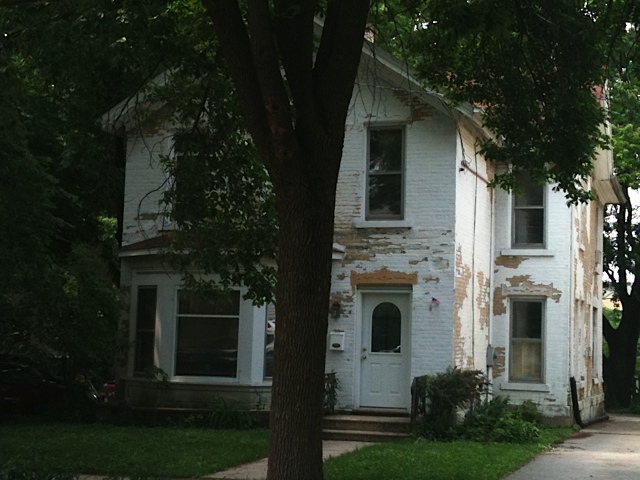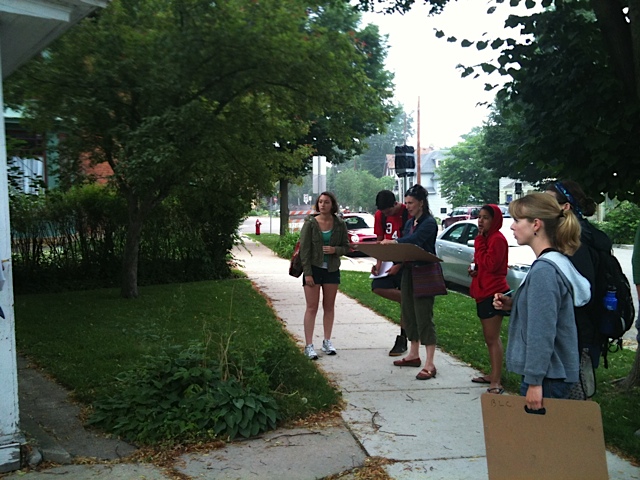2011 Summer Field School in Third Lake Ridge, Madison, Wisconsin
Fieldwork conducted by students in a summer course taught by Anna Andrzejewski at UW—Madison.
740 Jenifer Street
By Emily Belknap, Amy Brabender, Kayla Jemison, and Margaret Raimann
The Vogel II house, located at 740 Jenifer Street, is a modified example of an upright and wing house, popular in the Third Lake Ridge neighborhood, especially in the 1860s and 1870s. Its wood frame, adorned with shingle siding, used to be a classic upright and wing, consisting of a two-story gable front section with a one-story side ell (or "wing"). The form was popular in part because it was easy to construct (short timbers could be used for the two gabled sections), fashionable (the front facing gable exemplified the Greek Revival style, which remained popular in Madison into the later nineteenth century), and because it could be expanded easily by adding a second story to the wing. Before 1892 a kitchen was added to the original frame and construction between 1892 and 1898 added a porch onto the front and a shed attached to the kitchen. Sometime after 1908, another addition expanded the second floor to hold two more bedrooms, creating a two-story wing. Evidence of this is visible today in the windows on the first and second floors of the wing that differ in size and type. The house currently stands with nine rooms: four bedrooms, one bath, a kitchen, dining room, living room, and an extra room off the living room that is inaccessible. In adding onto the second story, the direction of the stairs was altered to make room for the extra bedrooms and allow for the addition of an interior bathroom. The remains of a doorway from the living room can still be seen on the wall of the staircase. These modifications to the original house can be explained through the introduction of interior plumbing, as well as the need for space for the large family that inhabited it for over 100 years.
The house was presumably built between the late 1850s and 1860s. In 1868 Hans P. Hanson, who also owned the Klose cottage next door, sold the house to Olaus Lundh. Two years later Lundh sold it to Adolph Klose, who owned the Klose cottage. Within the same year, Klose sold the house to Henry Christoffers, a well-known carpenter in the furniture and undertaking business who occupied the house for the next 30 years. Christoffers's undertaking business, Christoffers & Co., which was considered the first undertaking company in the area, was located on West Main Street, a 20 minute walk from his home on Jenifer Street. The close proximity between work and home was common for residents of the Third Lake Ridge neighborhood. In 1908, the Christoffers sold the property to Joseph Weiss, a hardware salesman and father of the current owner and occupant, Frances A. Weiss. Joseph Weiss lived in the home with his wife, Frances Ryan, and six children: Florence "Marie", Helen, Frances, Joseph, Richard "Glenn", and George. The 1920s addition, which added two more bedrooms and an interior bathroom, helped fit the growing extended family. Although Joseph and Frances's son George lived in Seattle he, his wife, and his children frequently visited the home. In 1927, the house was foreclosed upon and sold to Guarantee Holding Company. After finding that the legal wording in the foreclosure documents had been incorrect, the house was sold back to the Weisses in 1928. The house then stayed in the family for the next 80 years, with ownership divided amongst the Weiss children and grandchildren. After the deaths of both Joseph and Frances Ryan, the home was split amongst the remaining children and grandchildren. In 1975 they sold their portions of ownership to their aunts Florence, Frances, and Helen. After Florence's death in 1975, she divided the property between her living brother George, her sisters Frances and Helen, and her deceased brother Glenn's children. In 1977, the grandchildren sold it back to Frances and Helen, who became joint tenants of the property. When Helen died in 1986 the property was passed solely to Frances, who still lives in the home today.
The Vogel II house, located at 740 Jenifer Street, is a modified example of an upright and wing house, popular in the Third Lake Ridge neighborhood, especially in the 1860s and 1870s. Its wood frame, adorned with shingle siding, used to be a classic upright and wing, consisting of a two-story gable front section with a one-story side ell (or "wing"). The form was popular in part because it was easy to construct (short timbers could be used for the two gabled sections), fashionable (the front facing gable exemplified the Greek Revival style, which remained popular in Madison into the later nineteenth century), and because it could be expanded easily by adding a second story to the wing. Before 1892 a kitchen was added to the original frame and construction between 1892 and 1898 added a porch onto the front and a shed attached to the kitchen. Sometime after 1908, another addition expanded the second floor to hold two more bedrooms, creating a two-story wing. Evidence of this is visible today in the windows on the first and second floors of the wing that differ in size and type. The house currently stands with nine rooms: four bedrooms, one bath, a kitchen, dining room, living room, and an extra room off the living room that is inaccessible. In adding onto the second story, the direction of the stairs was altered to make room for the extra bedrooms and allow for the addition of an interior bathroom. The remains of a doorway from the living room can still be seen on the wall of the staircase. These modifications to the original house can be explained through the introduction of interior plumbing, as well as the need for space for the large family that inhabited it for over 100 years.
The house was presumably built between the late 1850s and 1860s. In 1868 Hans P. Hanson, who also owned the Klose cottage next door, sold the house to Olaus Lundh. Two years later Lundh sold it to Adolph Klose, who owned the Klose cottage. Within the same year, Klose sold the house to Henry Christoffers, a well-known carpenter in the furniture and undertaking business who occupied the house for the next 30 years. Christoffers's undertaking business, Christoffers & Co., which was considered the first undertaking company in the area, was located on West Main Street, a 20 minute walk from his home on Jenifer Street. The close proximity between work and home was common for residents of the Third Lake Ridge neighborhood. In 1908, the Christoffers sold the property to Joseph Weiss, a hardware salesman and father of the current owner and occupant, Frances A. Weiss. Joseph Weiss lived in the home with his wife, Frances Ryan, and six children: Florence "Marie", Helen, Frances, Joseph, Richard "Glenn", and George. The 1920s addition, which added two more bedrooms and an interior bathroom, helped fit the growing extended family. Although Joseph and Frances's son George lived in Seattle he, his wife, and his children frequently visited the home. In 1927, the house was foreclosed upon and sold to Guarantee Holding Company. After finding that the legal wording in the foreclosure documents had been incorrect, the house was sold back to the Weisses in 1928. The house then stayed in the family for the next 80 years, with ownership divided amongst the Weiss children and grandchildren. After the deaths of both Joseph and Frances Ryan, the home was split amongst the remaining children and grandchildren. In 1975 they sold their portions of ownership to their aunts Florence, Frances, and Helen. After Florence's death in 1975, she divided the property between her living brother George, her sisters Frances and Helen, and her deceased brother Glenn's children. In 1977, the grandchildren sold it back to Frances and Helen, who became joint tenants of the property. When Helen died in 1986 the property was passed solely to Frances, who still lives in the home today.
743 Williamson Street
Michael and Susan Zwank Residence
By Margaret Raimann
The Michael and Susan Zwank residence, located at 743 Williamson Street, is an essential part of the cultural landscape in the Historic Third Lake Ridge Neighborhood. Michael Zwank built the single family dwelling in 1857 in an area where residents were building similar homes as the result of an industrial boom. The house is built in a Gabled-Ell style, like many of others of the time both regionally and nationally. However, what sets the Zwank residence apart from many houses in Third Lake Ridge is its side-passage entrance. Most of the houses in the neighborhood have a front-passage, again paralleling regional and national styles of the time. The existence of a side passage could indicate cultural or environmental factors. If the Zwank family emigrated from Eurpoe, where the side-passage entrance is common, then it could indicate heritage remnants. The side passage style is also common in southern states such as Louisiana and Georgia, so it is possible that the Zwanks settled there first and then brought the style to Madison. The location of the house on fast-developing Williamson Street may have been a factor in its design. It was, however, one of the first structures to be built on the street.
The Zwank residence as it stands today was built in three phases. The first period exhibited a typical German plan, which again suggests the Zwanks's possible European origin. This closed plan features a stove in the center of the floor plan, where the remnants of a chimney are seen today. The house's second phase is difficult to date. The addition can be seen on the exterior where the foundation changes. The earliest Sanborn maps are for 1885, and the addition appears during that year. Michael and Susan Zwank lived in the residence with their eight children, so perhaps that made a quick addition necessary. The third period includes a small addition on the back of the house, and its construction date is also difficult to determine. This addition appears larger in the 1942 Sanborns, so the construction could have occurred some time in the 1930s or 1940s. Overall, the phases of the house are difficult to see due to reconstruction--the siding of the frame house has been replaced, the foundation reinforced, the porch redone, etc. The Sanborn maps offer some clues to the phases of the Zwank house as well as interior details such as the chimney placement and evidence of a stove.
Michael Zwank originally owned the property when he built the house in 1857. After his death in 1883, Zwank left the property to his eight children. His daughter, Elizabeth Zwank, married Fred Steinsberger, a cigar maker at H. Grove & Sons. Elizabeth and Fred lived in the house until his death in 1930. Around 1931, deeds indicate that the property was passed to Jack Clark. This transition may indicate when the house was converted into apartment rentals, which is its use today. According to the city directories, neither Jack Clark nor anyone with the last name Clark lived in the house, and the residents who did live there only resided for one to three years. This transition could also indicate when the last addition to the house was built, as the space is used for storage and a bathroom in one of the one-bedroom apartments.
In conclusion, the Zwank residence makes up an integral part of the Third Lake Ridge Neighborhood both in its example as a vernacular dwelling and as an anomaly. It has served as a home for working-class Madison residents during the industrial boom in the area. Today, like many of these once-single-family-dwellings, it is a rental property. The physical appearance of the building, with a side passage and razed foundation, makes it inconsistent with the other vernacular houses in the neighborhood. Though it is difficult to date the Zwank residence and observe its original features, it is a notable vernacular site and adds depth to the cultural landscape of Third Lake Ridge.
The Michael and Susan Zwank residence, located at 743 Williamson Street, is an essential part of the cultural landscape in the Historic Third Lake Ridge Neighborhood. Michael Zwank built the single family dwelling in 1857 in an area where residents were building similar homes as the result of an industrial boom. The house is built in a Gabled-Ell style, like many of others of the time both regionally and nationally. However, what sets the Zwank residence apart from many houses in Third Lake Ridge is its side-passage entrance. Most of the houses in the neighborhood have a front-passage, again paralleling regional and national styles of the time. The existence of a side passage could indicate cultural or environmental factors. If the Zwank family emigrated from Eurpoe, where the side-passage entrance is common, then it could indicate heritage remnants. The side passage style is also common in southern states such as Louisiana and Georgia, so it is possible that the Zwanks settled there first and then brought the style to Madison. The location of the house on fast-developing Williamson Street may have been a factor in its design. It was, however, one of the first structures to be built on the street.
The Zwank residence as it stands today was built in three phases. The first period exhibited a typical German plan, which again suggests the Zwanks's possible European origin. This closed plan features a stove in the center of the floor plan, where the remnants of a chimney are seen today. The house's second phase is difficult to date. The addition can be seen on the exterior where the foundation changes. The earliest Sanborn maps are for 1885, and the addition appears during that year. Michael and Susan Zwank lived in the residence with their eight children, so perhaps that made a quick addition necessary. The third period includes a small addition on the back of the house, and its construction date is also difficult to determine. This addition appears larger in the 1942 Sanborns, so the construction could have occurred some time in the 1930s or 1940s. Overall, the phases of the house are difficult to see due to reconstruction--the siding of the frame house has been replaced, the foundation reinforced, the porch redone, etc. The Sanborn maps offer some clues to the phases of the Zwank house as well as interior details such as the chimney placement and evidence of a stove.
Michael Zwank originally owned the property when he built the house in 1857. After his death in 1883, Zwank left the property to his eight children. His daughter, Elizabeth Zwank, married Fred Steinsberger, a cigar maker at H. Grove & Sons. Elizabeth and Fred lived in the house until his death in 1930. Around 1931, deeds indicate that the property was passed to Jack Clark. This transition may indicate when the house was converted into apartment rentals, which is its use today. According to the city directories, neither Jack Clark nor anyone with the last name Clark lived in the house, and the residents who did live there only resided for one to three years. This transition could also indicate when the last addition to the house was built, as the space is used for storage and a bathroom in one of the one-bedroom apartments.
In conclusion, the Zwank residence makes up an integral part of the Third Lake Ridge Neighborhood both in its example as a vernacular dwelling and as an anomaly. It has served as a home for working-class Madison residents during the industrial boom in the area. Today, like many of these once-single-family-dwellings, it is a rental property. The physical appearance of the building, with a side passage and razed foundation, makes it inconsistent with the other vernacular houses in the neighborhood. Though it is difficult to date the Zwank residence and observe its original features, it is a notable vernacular site and adds depth to the cultural landscape of Third Lake Ridge.



